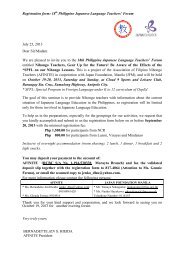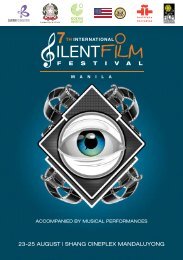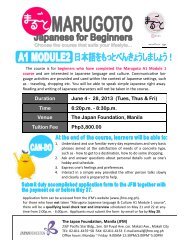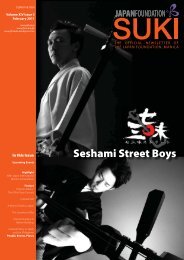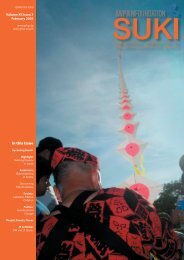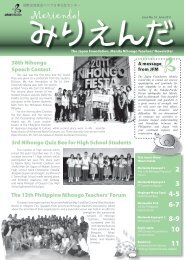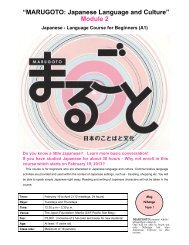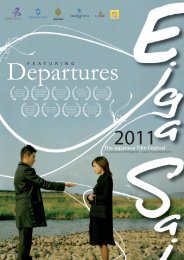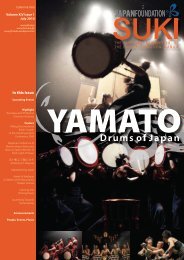Merienda! - The Japan Foundation, Manila
Merienda! - The Japan Foundation, Manila
Merienda! - The Japan Foundation, Manila
Create successful ePaper yourself
Turn your PDF publications into a flip-book with our unique Google optimized e-Paper software.
独 立 行 政 法 人国 際 交 流 基 金<strong>Merienda</strong>!<strong>The</strong> <strong>Japan</strong> <strong>Foundation</strong>, <strong>Manila</strong>NIHONGO TEACHERS’ NEWSLETTERみりえんだVolume V Number 3 ・July-August 2008This Issue’s MenuWhat’s inside?<strong>Merienda</strong> Espesyal 1 NihongoFiesta….Page 2-3<strong>Merienda</strong> Espesyal 2 <strong>The</strong>7th Teachers’ Forum….Page 4-5<strong>Merienda</strong>’s Pick NihongoCaravan & Jenesys….Page 6Sapin-sapin <strong>The</strong> JFM LectureSeries photos….Page 7Magkape Muna Tayo!Comings & Goings….Page 8-9Halo-Halo Glossary, Dear MSensei….Page 10Banana-Q Events &Announcements….Page 11NihongoFIESTA 2008This year’s Nihongo Fiesta was held onFebruary 23, at the Shangri-La Plaza Mall. <strong>The</strong>event started off in the morning with the annualNihongo Speech Contest, where contestants from3 different divisions, the Student, the Non-studentand the Open Divisions vied for the prestigiousprizes. This year, a balanced distribution of participantswas chosen from <strong>Manila</strong>, Davao and Cebu.Preliminary Speech Contests were held in both Davaoand Cebu, and the winners of these contests,together with those who passed the <strong>Manila</strong> screening,were the participants in this year’s contest.<strong>The</strong> coveted weeklong Study Tour in <strong>Japan</strong>,which was awarded by none other than H.E.Ambassador Makoto Katsura, went to the Championof the Non-Student Division and winner ofthe Outstanding Performance Award, Ms. MaricelBornilla of the Philippine Institute of <strong>Japan</strong>ese Language& Culture.During lunch, the audience was treated tothe performance of the <strong>Manila</strong> Express band,J-Taste@<strong>The</strong> Shang!!whose members are all <strong>Japan</strong>ese expatriates, and toa lively dance number by the members of the Associationof Filipino Nihongo Teachers.In the afternoon, the first <strong>Japan</strong>ese PerformanceContest was held, with 8 groups participating.<strong>The</strong> first place winner was the group composedof students from Adamson University and<strong>Manila</strong> Science High School, who performed the<strong>Japan</strong>ese festival dance called Awaodori in full costume.<strong>The</strong> second place went to the University of<strong>Manila</strong>, with their performance entitled “HighSchool Musical”, a medley of songs from variousDisney movies. <strong>The</strong> Fire Exit Band of the La SalleGreenhills won the third place with the song anddance number entitled “Shizuku” and “Aozora noNamida”.Everybody enjoyed the entertaining activitieswhere both the participants and the audience wereable to relish the different flavors of this year’s NihongoFiesta.
<strong>Merienda</strong>*Espesyal 1CONGRATULATIONS TO THE WINNERS OF THE SPEECH CONTEST!!OPEN DIVISIONGrand Prize Winner & ChampionMs. Gerlie Joy Balunto(MKD,Davao)"My Life as a Factory Worker in <strong>Japan</strong>"ファクトリーワーカーRunner-UpMs. Aiko Kristiana Piquero Ballescas(Alliance Software, Cebu)"My Appreciation of Elderly Across Two Cultures"文 化 の 違 いから 見 えた 思 いやりNON-STUDENT DIVISIONOutstanding Performance Award & ChampionMs. Maricel Bornilla (PIJLC, <strong>Manila</strong>)"Transcending A Japayuki" ジャパユキを 超 えてRunner-UpMs. Jocelyn Ong ( AWS)" <strong>The</strong> Me in <strong>Japan</strong>" 日 本 の 私STUDENT DIVISIONChampionMs. Shane Pajegal (MKD,Davao)"My Secret Emotion" 日 本 語 でしか 言 えないことRunner-UpMs. Sheilla L. Pamittan(UP Diliman)"Pastel Colored Future" パステルの 色 の 未 来SPECIAL JURY AWARDMs. Kristine Corpuz(MKD,Davao)"Kanji Lessons with my Grandfather" 祖 父 と 私 の 漢 字 教 室Here is a recount of how the Awaodori Groupcame up with their prize winning performance.Awaodori is one of the most famous festival dances in <strong>Japan</strong>.<strong>The</strong> Awaodori is said to have originated from the Bon Festival, whichwelcomes back the spirits of the ancestors.“Nothing is impossible”. This was the fighting stand of a groupof dynamic and energetic young men and women from Adamson Universityand <strong>Manila</strong> Science High School who gallantly fought against all odds to eventually capture the title as the kings and queensof the dance floor in the <strong>Japan</strong> <strong>Foundation</strong> <strong>Manila</strong>’s Nihongo Fiesta performance contest held at the Shangri-La Plaza Mall in MandaluyongCity. <strong>The</strong> said event was organized to showcase the richness of the <strong>Japan</strong>ese culture which, from time immemorial has enchantedpeople from all walks of life.<strong>The</strong> journey towards the glory was not as easy as everyone might think. <strong>The</strong> throne was not given on a silver platter. <strong>The</strong>students had to endure many challenges and obstacles which threatened the ultimate goal of bringing home the cherished championshiptrophy. Scheduling became a major concern since the members of the dance group came from different schools. Added tothat problem was the limited time given to prepare. But the group was fortunate because of the excellent stewardship of OsamuSato Sensei, Soushi Uchiyama Sensei, Kayo Nishimura Sensei and Flordeliza Idanan Sensei. Every piece of the puzzle was put in itsproper place, thus creating a well oiled dancing team, wherein everyone was willing to sacrifice personal comfort for the success ofthe group. Everyone did his part, knowing the fact that in a group competition, cooperation and unity are vital elements towardsthe accomplishment of the Herculean task ahead.<strong>The</strong> group had to execute the “awaodori dance” as flawlessly as possible. To achieve such goal, each member was focusedin every practice session. To offset the problem of not being able to meet on a regular basis, the students trained in their own respectiveschools in the first phase of the preparation, mastering the different steps to create the dance that would change a part of theirlives. Later on, group practices were scheduled for the final phase in preparation for the real acid test of artistic excellence. <strong>The</strong> grouphad to deal with the short time left to perfect the presentation; and, the rest is history.<strong>The</strong> group believes that winning is not everything. <strong>The</strong> trophy was an added bonus to the real prize. Each member gaineda lot of friends, who never failed to lighten the mood and raise the team spirit when disappointments came into play. Not to mentionthe tons of experiences that will be cherished forever by all the members of the group, be it good or bad, they will all be rememberedas part of learning and growing up.<strong>The</strong> competition revealed the hidden gifts of the students who were bold enough to spread the wings of their creative spiritsand share their God given talents. Students opted to get out of their own shell for personal and professional growth. It is not only thefeeling of being able to compete and win in the process, but the feeling of doing something one likes and doing it for other people.One member mentioned, “It was a tough battle we engaged in, but it was won not by individual talents, but by the concertedeffort of each member sincerely put into the craft everybody loves.2Richard Bumanlag is a 5 th year BS ComputerEngineering student of AdamsonUniversity. He is the current president ofthe Bunka Kouryuu Kai (Cultural ExchangeSociety), whose members wereincluded in the group which garneredfirst prize in the performance contest ofJFM’s Nihongo Fiesta.みりえんだ
Winning Speech:‘Transcending a Japayuki’ by Maricel E. Bornillaこジャパユキを 超 えてきおもみなさんは、ジャパユキと 聞 くと、どう 思 いますか。わたしばんめあねわたし私 の2 番 目 の 姉 は、 元 ジャパユキです。 私 がまだ10 歳 ぐらいのときに、 姉 は 歌 手いなかひとかんががたほしゅてきあねさいわるくちあねかしゅにほんとして 日 本とうじへ 行 きました。 当 時コールの 田 舎 の 人 たちは 考 え 方 が 保 守 的 で、 姉 について 悪 口 を 言 っていたそうです。でも、 私 はまだ 子 供 だったのでわみやげかんがあねいにほんよく 分 からず、お 土 産 のことしか 考 えていませんでした。 姉 は 日 本 から 帰 ってくるたびに、 素 敵 な 服 や 靴 、かわいい 鉛 筆 、おいしいわたしおおよろこチョコレートやシーフードラーメンをくれ、 私 は 大 喜 びしていました。おおまわ ひとわるくち い み わおもにほん わるでも、 大 きくなるにつれて、 周 りの 人 たちの 悪 口 の 意 味 が 分 かるようになり、つらい 思 いをしました。「ジャパユキは 日 本 で 悪 いことかね もうわるくち なんど みみふか きずあねうわさ きをして、お 金 を 儲 けてる」という 悪 口 を 何 度 も 耳 にし、 深 く 傷 つきました。そんなとき、 姉 は「そういう 噂 は 気 にしないで。ジャパユわるかぎいじじつキといっても 悪 いことをしているとは 限 らない」と 言 いました。 事 実 、 姉 は 歌 手 としてだけ 仕 事 をし、 日 本 で 知 り 合 った 男 性 と 結 婚こども にん めぐにほんじん しゅじんやさ かた あね いま にほん しあわ かていせいかつ おくし、 子 供 3 人 に 恵 まれました。 日 本 人 のご 主 人 はとても 優 しい 方 で、 姉 は 今 でも 日 本 で 幸 せな 家 庭 生 活 を 送 っています。わたしいまあねかんしゃちちな私 は 今 でもこの 姉 にとても 感 謝 しています。 父 が 亡 くなってから、 母 と 私 たち 兄 弟 の 面 倒 を 見 てくれ、おかげで 私 たちは 学 校 をそつぎょう卒 業 することができました。あね かぞく わたしあいだ もんだい ことば かべあね こどもにっぽんうにほんそだにほんご姉 の 家 族 と 私 たちの 間 の 問 題 は 言 葉 の 壁 です。 姉 の 子 供 たちは 日 本 生 まれの、 日 本 育 ちなので、 日 本 語 しかできません。そして、わたしははにほんごぜんぜんふつうあねつうやく私 の 母 は 日 本 語 が 全 然 できません。 普 通 は 姉 が 通 訳 するのですが、ある 時 、 母 が 国 際 電 話 で 孫 に 直 接 気 持 ちを 伝 えようとしました。でははなんいわくやかなおもははかえあねわたしときかしゅははきょうだいこくさいでんわめんどうわたしすてきしごとまごみふくこどもくつにほんちょくせつきもも、 母 は 何 と 言 ったらよいのか 分 からず、とても 悔 しく 悲 しい 思 いをしたそうです。わたし にほんご べんきょう はじにほんごき そ べんきょうにほんごぶんかがくいん ほんかくてき まなそんなこともあって、 私 は 日 本 語 の 勉 強 を 始 めました。 日 本 語 センターで 基 礎 を 勉 強 し、フィリピン 日 本 語 文 化 学 院 で 本 格 的 に 学にほんごのうりょくしけんきゅうごうかくにほんごりょくみび、 日 本 語 能 力 試 験 2 級 合 格 レベルの 日 本 語 力 を 身 につけることができました。おかげで、 今 では 姉 の 子 供 たちとも 日 本 人 の 義 理 の 兄ちょくせつにほんご はなとも 直 接 日 本 語 で 話わたしにほんごすことができ、 日 本 語にほんごきょうしははのできない 母たや 他いまあねこどもきょうだいつうやくの 兄 弟 のために 通 訳 もできるようになりました。私 はこれから 日 本 語 教 師 になり、 日 本 で 仕 事 をするフィリピン 人 、 特 にITエンジニアやケアギバーを 助 けたいと 思 っています。そわたしにほんたすしごとうすることが、ジャパユキとして 私 を 助 けてくれた 姉 への 恩 返 しにもなると 思 います。あねおんがえじんMaricel E. Bornilla has been studying Nihongo forless than 2 years. She took up the Intensive Courseat the Philippine Institute of <strong>Japan</strong>ese Languageand Culture last year, and is presently enrolled inthe Teacher Training Course at the Nihongo Center<strong>Foundation</strong> in <strong>Manila</strong>. She is currently teaching atthe Atienza Nippi, and is handling Children’s Nihongoat the Nihongo Center <strong>Foundation</strong>.とくおもたすしつたのビあえんぴつわたしおもだんせいにほんじんけっこんがっこうぎ りあにStudents Bag the Crown!!<strong>The</strong> First <strong>Japan</strong>ese Performance Contest WinnersFIRST PLACE - ‘Awaodori’ by Adamson University & <strong>Manila</strong> Science High SchoolSECOND PLACE - ‘High School Musical’ by <strong>The</strong> University of <strong>Manila</strong>THIRD PLACE - ‘Shizuku’ & ‘Aozora no Namida’ by the Fire Exit Band of La SalleGreenhills<strong>The</strong> <strong>Japan</strong> <strong>Foundation</strong> <strong>Manila</strong> Nihongo Teachers’ Newsletter3
4<strong>Merienda</strong>*Espesyal 2THE 7TH NIHONGO TEACHER’S FORUM<strong>Japan</strong>ese Pop Culture & <strong>Japan</strong>ese Language EducationMay 16 & 17 :<strong>The</strong> 7th Teachers’ Forumat a GlanceDay 1 Host: Ms. Jenny HieidaTowards Developing the <strong>Japan</strong>ese Content industriesMr. Koji Hanawa<strong>Japan</strong> External Trade Organization, <strong>Manila</strong> CenterPhilippine Animation Education and the Impact of<strong>Japan</strong>ese Language Training in a Competitive GlobalAnimation LandscapeProf. Rudyard Contreras PesimoAteneo de Naga UniversityMy Filipino Seiyuu Life -Making of Anime Tagalog versionMs. Charmaine “Omi” Cordoviz,Freelance Anime Voice Actor / Translator & Scriptwriter<strong>The</strong> influence and application of the Anime & MangaBoom on <strong>Japan</strong>ese Language EducationMs. Nanae Kumano,<strong>The</strong> <strong>Japan</strong> <strong>Foundation</strong><strong>Japan</strong>ese-Language Institute, KansaiDay 2 Host: Ms. Gennie FermaWorkshop : Conducting a <strong>Japan</strong>ese Language Classwith the use of AnimeMs. Nanae Kumano,<strong>The</strong> <strong>Japan</strong> <strong>Foundation</strong><strong>Japan</strong>ese-Language Institute, KansaiPractical Report: J-pop de Benkyou shiyou:Using J-pop Music in Teaching NihongoU.P. Department of Linguistics,<strong>Japan</strong>ese Language Teachers: Ms. Florinda Palma-Gil,Ms. Ria Parsram, Mr. Ian Duenas,Ms. Farah Cunanan, Ms. Weng AlvarezBridging Generations -An Introduction to <strong>Japan</strong>esePop Culture for Nihongo teachersMs. Iza Shuman SogiDe La Salle University<strong>The</strong> Push to be a Parasaito Shinguru: Messages andValues on Love and Marriage from J-doramaMs. Kristine Grace B. ReyesU.P. Asian CenterReports from the Teacher Trainees of the <strong>Japan</strong> <strong>Foundation</strong>,<strong>Japan</strong>ese Language Institute, Urawa1. Kyouan......tsukurimashou, Ms. Teresita Fujita2. Para-phrasing, Ms. Anna Marie Badilla3. Reading Composition Through Short StoriesMs. Juvilly Ng4. As Raw as we can be: <strong>The</strong> use of Namakyouzai,Ms. Farah CunananNetworking SessionTopic: Let us make use of <strong>Japan</strong>ese Pop Culture in ourNihongo ClassesFacilitator: Ms. Chieko NakaGroup Coordinators: Ms. Cora Shobiri, Ms. Tess Doña,Ms. Chesca VenturaMae Coloma is one of the fortunate recipients of this year’s LongTerm Training Program for Teachers of the <strong>Japan</strong>ese Language.She has been attending several of the <strong>Japan</strong>ese LanguageCourses offered at the <strong>Japan</strong> <strong>Foundation</strong> <strong>Manila</strong>. Her new foundhobby is taking the Level 1 <strong>Japan</strong>ese Language Proficiency Test<strong>The</strong> 7 th Nihongo Teacher’s forum was held last May 16 and 17 with thetheme, <strong>Japan</strong>ese Pop Culture and <strong>Japan</strong>ese Language Education. I was tempted todo a thorough run down of everything that happened that time. Like a stenographer,I dutifully transcribed the goings on during the two days. I even took totaking pictures whenever my hand went numb. This was going to be a boringdocumentary (“Around this time of year, a species known as ‘Filipino NihongoTeachers’ flock to their mecca, the Nihongo Teachers Forum…”). This was goingto be a riveting novel (“Mina-san, konbanwa,” Hieida-sensei said. <strong>The</strong> audiencewas at a loss on how to answer…). Unfortunately,I couldn’t read my own scribble so Idecided to just touch on the highlights. So heregoes...If Simbang Gabi has Bibingka andPuto Bumbong, Nihongo Teacher’s Forum hasEmpanada and Mamon. While partaking of thetraditional fare, everyone was acquainting and re-acquainting with each another.This was, after all, about the only time some people see each other. I found myselfloitering around the snacks table, having an internal debate on the merits anddemerits of denying oneself a tasty, calorific snack. I knew it was time when Iheard Iizawa-san say, 「アラサイスナ」. I can’t get over how good hisFilipino is. Emceed by the beautiful Hieida-sensei, the first day was started off byJFM Director Ben Suzuki. In his opening remarks, Mr. Suzuki extolled on the growing‘infrastructure’ of Nihongo Education as seen by the Nihongo Caravan, theJenesys program, the some 200 college students sent to <strong>Japan</strong>, the 4 Filipinoteachers training in <strong>Japan</strong> right now, and the 5 young <strong>Japan</strong>ese teachers dispatchedto different regions in the Philippines. Deputy Chief of Mission of the Embassyof <strong>Japan</strong>, Minister Hidenobu Sobashima was guest speaker. In his speech hereports the embassy is “happy to know <strong>Japan</strong>ese culture is extensively acknowledgedall over the world” and that the Ministryof Foreign Affairs has set up an Overseas ExchangeCounsel of 17 people both from academiaand J-pop culture to look into how to improve,how to market, and where to begin thiscultivation of J-pop culture to the world. Twobig events already in motion: <strong>The</strong> InternationalManga Award (now on its second year), and theAnime Ambassador of <strong>Japan</strong>: Doraemon. As he says, the ultimate goal of culturalexchange is making friends. Living in Nobita’s neighbourhood, Doraemon hasalready made a lot of friends all over the world. With his government official visaand his 「どこでもドア」, he is sure to reach (without getting deported)a lot more of the people. I wonder if he’ll have to wear a suit now...<strong>The</strong>re were four speakers on the first day, the first of which was Mr.Hanawa who talked about the <strong>Japan</strong>ese content industry and mentioned the establishmentof the CJ Mark. <strong>The</strong> CJ Mark label is used to identify genuine <strong>Japan</strong>esecontent from illegal copies. Perhaps a sore point for the owner of any intellectualproperty is the prevalence of infringements in Asia. Always a rich area for debate,one participant (in another session) sincerely said a lot of the Filipino otakus actuallywant an original copy of their manga or anime. <strong>The</strong> only problem is the avail-みりえんだ
ability.<strong>The</strong> next speaker was lively Prof. Pesimowho gave a passionate talk about the Filipino animeindustry. To know that 80% of the TOIEI workforce isfrom the Philippines is jaw-dropping. But then again,we’ve got Filipino animators at Walt Disney so I guessanime can’t be far behind. Where does Nihongo educationcome in? If animators can’t be bothered to study<strong>Japan</strong>ese Language, the presence of a resident languageexpert could be of value to translate or clarify instructions from the <strong>Japan</strong>ese contractor. He gave special mention to his friend and boss, MsGrace Dimaranan, who came for moral support. Ms Dimaranan is part of the Animation Council (www.animationcouncil.org) and welcomes visits to theanimation studios (advanced, advanced notice, please… busy busy busy).Next to speak was Ms. Cordoviz, whose voice anybody with a television set will have heard of. Channel7’s SlamDunk, Channel 13’s Super Boink, Channel 11’s Prince of Tennis are just some among the many of her work.She professed to being shy, claiming that’s why she is a voice talent. She generously shared her life experiences inthe industry, how she was “discovered” while sitting in to watch a dubbing, how her friends at first weren’t tookeen on watching dubbed anime, and how the life of a dub artist here is different (you read the script for the firsttime while dubbing? – that’s talent).<strong>The</strong> last speaker for the day, err, night, was Ms. Kumano from the Kansai Language Institute. Differentin concentration from the Urawa Institute, the Kansai Language Institute concerns itself primarily with research. Herresearch focused on how anime can be used as an aid for teaching the <strong>Japan</strong>ese Language. Since many young peoplestart learning Nihongo because of their desire to understand Anime in the original language, it seems inevitable thatNihongo teachers should start watching Anime to be in tune with the students, and also to be able to effectively useAnime in their lessons. Although it was quite late, the audience did not pass up the chance of being able to listen toan actual voice talent, and so did not let go of Ms. Cordoviz so easily. She did some voices for the audience whichthey loved. She did one of the Hamtaro characters, “kelan mo ba ako pakakainin…” A participant couldn’t helphimself and answered, in character, “oo nga kain na tayo, nagugutom na rin ako.” And with that collective Freudianvoice, the first day of the 7 th Nihongo Teacher’s Forum came to an end.<strong>The</strong> second day proved to be as exciting, or even more so. With the eagerness of a newly hatched chick, I trod off to the RCBC Building(hereafter known as “<strong>The</strong> Mecca”) and registered for the day’s forum. Ms. Nanae Kumano started with a workshop on how to conduct a class usinganime. We were grouped into fours and each member was made to talk about any of the anime characters she mentioned. Interestingly, a number of theteachers turned out to be otakus. <strong>The</strong> next session was about UP professors from the Department of Linguisticsdemonstrated the use of J-pop music in class. <strong>The</strong> teachers were so impressed that they asked for copies of theactivities. In the true spirit of cooperation, the UP teachers were very gracious and agreed to provide copies toAFINITE. Fresh from the <strong>Japan</strong> <strong>Foundation</strong> Language Institute in Urawa, the teacher trainees shared with us theirlearning. In the networking session, we separated into three groups and discussed how to make use of anime inclass. After this, each group shared their input with the whole body. And then in the closing ceremony, Mr. HoshiToru made his farewell speech. It was bittersweet. Truth to tell, it was Hoshi-sensei who persuaded me to go tothe <strong>Japan</strong> <strong>Foundation</strong>. Without him, I would have been a nameless, faceless entity in the sea of Filipino NihongoTeachers. I wish he would stay forever in the Philippines. Mr. Nobuaki IIzawa also made a farewell speech, as he will be leaving in June. June 13. Friday(!). What an unlucky day for the Philippines to lose such a charming man. And as if this torrent of emotions weren’t enough, Mr. Yasuyuki Niimi makes hisentrance (re-entrance?) into the <strong>Japan</strong>ese Language scene in the Philippines. Without knowing much about him, I could tell his “era” was going to be aninteresting ride. In his speech, he says, “I’m back --- home…”Networking Session: <strong>The</strong> use of <strong>Japan</strong>ese Pop Culture in our Nihongo ClassesHave you heard of the term “J Pop Culture”? Do you know what it means?<strong>Japan</strong>ese Popular Culture, or “J Pop Culture” as it is called, does not have an absolute definition. It is represented by what is perceived to be popularly andwidely accepted in <strong>Japan</strong>ese society and covers pop songs, jazz, enka, karaoke, manga, anime, video games, TV drama, films and “idols”.J Pop Culture was the topic of the recently held networking session during the latest Nihongo Teachers’ Forum wherein <strong>Japan</strong>ese language teachers shared theirthoughts on <strong>Japan</strong>ese Pop Culture and its effect in teaching <strong>Japan</strong>ese language to the students. Listed here are the impressions of the teachers on J Pop Culturebased on what they have experienced, and heard from their respective students:Most young students are very interested and well-informed on J Pop Culture,, while the older ones do not have the time nor interest to be exposed to J Pop.J Pop culture, especially anime and manga, are fun and effective tools to motivate the students, so teachers should exert effort and learn more about J Pop.Teachers in the universities have difficulty in incorporating anime in their syllabus because they have the university syllabus to followDuring the networking session, <strong>Japan</strong>ese language teachers also shared their ideas on how to use the different forms of J Pop Culture such as anime, manga andJ-pop, in conducting a lesson. Below are the details:Teachers should screen the content of the materials to be used, and use materials which are not so difficult for the students.Anime, manga and J-pop are effective tools for introducing <strong>Japan</strong>ese culture through language., and even for comparing it to our own culture.It can be used for classroom exercises like filling in the blanks while listening, trying to sing along with the theme songs karaoke style, asking the students toexplain what is going on in a scene by making up their own dialogues, or asking the students to write the keywords they hear.It would be ideal if a database containing materials taken from J Pop were to be created since not all teachers are familiar with J Pop.Before, most students took Nihongo courses to pursue a <strong>Japan</strong>ese-related career, but now, many students learn Nihongo because of their interest in J Pop culture.Teachers are now faced with the challenge of keeping up with the trend, in order to relate and to communicate well with their students.<strong>The</strong> <strong>Japan</strong> <strong>Foundation</strong> <strong>Manila</strong> Nihongo Teachers’ Newsletter 5
<strong>Merienda</strong> Espesyal 3日 本 語 を べんきょう、たのしもう!Start up Nihongo class in High schools!!Metro <strong>Manila</strong> High Schools to start offering Nihongo to students<strong>The</strong> 'Nihongo Caravan', which started in November 2007 with the aim of arousing the interest of highschool students and teachers in <strong>Japan</strong>ese language and culture, was able to visit 7 high schools by the endof the school year in March. <strong>The</strong> schools visited were Makati Science High School, Philippine ScienceHigh School- Diliman Campus, Muntinlupa Science High School, Pasig City Science High School,Marikina Science High School, Torres High School and Caloocan Science High School.All the schools expressed their interest to hold <strong>Japan</strong>ese language classes for their students, and asa result, under the auspices of the Association of Filipino Nihongo Teachers (AFINITE) and the <strong>Japan</strong> <strong>Foundation</strong><strong>Manila</strong> (JFM), these seven high schools have been chosen as grantees of the Young Teachers DispatchProgramme of the <strong>Japan</strong>-East Asia Network of Exchange for Students and Youths (JENESYS).<strong>The</strong> <strong>Japan</strong>ese teachers, Ms. Shiho Asanome and Mr. Akihisa Yoneda will be teaching Nihongo with AF-INITE members in these high schools either as an Elective or as an extra-curricular course for the next tenmonths.Watch out for our next issue of ‘<strong>Merienda</strong>’ where we will be introducing the JENESYS teachers andthe nature of the courses they will be handling!わたしたちがおしえます!6 みりえんだ
<strong>The</strong> JF <strong>Manila</strong> Lecture Series Photo DiarySapin-sapin. A rice cake in layers of different colors. One of a variety of kakaninSapin-sapinJFM Monthly L Le cture e Series月 例 日 本 語 教 育 研 究 交 流<strong>The</strong> monthly Lecture Series is an interactive endeavor (learning/ sharing) among Filipino, <strong>Japan</strong>ese and other overseasbasedlanguage teachers and specialists. It is a continuous effort for professional enrichment, and in general, for thefurther encouragement of <strong>Japan</strong>ese-language education and <strong>Japan</strong>ese studies in the Philippines. All presentations ofthe Lecture Series are held at the JF <strong>Manila</strong> office and are usually scheduled every last Friday of the month.Please take note of announcements of schedule changes.32nd SessionFriday, 8 February 2008Acquisition of Conditional Expressions among FilipinoStudents of <strong>Japan</strong>ese LanguageDr. Mary Ann Gaitan-BacolodAssistant professor, Dept. of LinguisticsCSSP, University of the Philippines, DilimanIt is said that <strong>Japan</strong>ese conditional expressions, such as “TARA”, “BA” are some of the mostdifficult to be acquired by foreign students since their usage and meaning are very similar. Dr.Bacolod presented her research about the problems encountered as well as the strategies usedby Filipino students in their acquisition of “TARA” and “BA” conditional expressions.Thursday, 6 March 2008<strong>Japan</strong>ese Culture and Society which is not writtenin textbooks19 students from Osaka University33rd Session<strong>The</strong> topic was tackled by 19 students from Osaka University majoring in <strong>Japan</strong>eseStudies. <strong>The</strong>y talked about the life of university students in <strong>Japan</strong>, information which isnot found in textbooks nor on the internet. This was a good opportunity to get to knowthe current lifestyle of the <strong>Japan</strong>ese youth.34th Session Friday, 4 April 2008<strong>The</strong> History of <strong>Japan</strong>ese Language Education At AWSMs. Ayako Minami<strong>Japan</strong>ese Language Advisor, Advanced World SolutionsThis being her last lecture before going back to <strong>Japan</strong>, Ms. Ayako Minami introducedvarious aspects of the AWS’ <strong>Japan</strong>ese Language Education Program such as the curriculum,unique activities (presentation contest, etc.), teaching of Business Nihongo,conducting JLPT reviews, the multifaceted role of the coordinator, etc.Friday, 27 June 2008<strong>Japan</strong>ese as a Heritage Language — A Case Studyof <strong>The</strong> <strong>Japan</strong>ese-Filipino Children in the PhilippinesMs. Alice Mary Itchon<strong>Japan</strong>ese Language Teacher, Nihongo Center <strong>Foundation</strong><strong>The</strong> increase in the number of <strong>Japan</strong>ese-Filipino marriages brings about the need fortheir children staying in the Philippines to study the <strong>Japan</strong>ese language. However, languageschools are not prepared for this type of learners - hence, the absence of a curriculum.Ms. Itchon reported on the current needs of these young learners – reasons/goals for studying the language, attitude towards <strong>Japan</strong>ese language schools, ethnicidentity, and parental involvement.35th Session<strong>The</strong> <strong>Japan</strong> <strong>Foundation</strong> <strong>Manila</strong> Nihongo Teachers’ Newsletter7
Magkape Muna Tayo!カフェ みりえんだKape. <strong>The</strong> Filipino word for coffee. A unique Philippine blend is barako, traditionally enjoyedas a sweet potent drink or to add zing to a helping of fried rice as a wake upper.に ほ ん ご きょういく ほしFAREWELL.... 日 本 語 教 育 アドバイザー: 星とおる亨みな げんき にほん げつ しゅっぱつ こんど皆 さんお 元 気 ですか。 日 本 に 帰 ってから1か 月 もたたないうちにマレーシアに 出 発 しました。 今 度 はこくさいこうりゅうききん しごと に ほ ん ご がっこう に ほ ん ご おし よてい国 際 交 流 基 金 の 仕 事 ではなくて、KL(クアラルンプル)の 日 本 語 学 校 で 日 本 語 を 教 える 予 定 です。フィリのこ しごと かぞく なか よ みな わかピンではまだまだやり 残 した 仕 事 がありますが、それよりも 家 族 のように 仲 良 くなった 皆 さんとお 別 れなにすることが、 何 よりつらかったです。ねんかんほんとう せ わ みな ぜったいわす とし なまえ わす2 年 間 本 当 にお 世 話 になりました。 皆 さんのことは 絶 対 忘 れません。( 歳 のせいで) 名 前 は 忘 れるかもねんご ことし がつ おこな だい かい みな ぜんいんしれませんが、それが、2 年 後 の 今 年 5 月 に 行 われた 第 7 回 のフォーラムでは、 皆 さんのほとんど 全 員 をし じぶん なかま かん しあわ知 っていました。そのときわたしは「あ、やっと 自 分 もみんなの 仲 間 になれたんだな」と 感 じて 幸 せでこうふく き も え いちばんたいせつ たからものした。その 幸 福 な 気 持 ちはわたしがフィリピンで 得 た 一 番 大 切 な 宝 物 です。かんが きょうし じん に ほ ん ご せんせい考 えてみると、フィリピンでは Non Native 教 師 (つまりフィリピン 人 の 日 本 語 の 先 生 )のほうが Nativeにほんじん せんせい おお き じん せんせいの(つまり 日 本 人 の) 先 生 よりずっと 多 いことに 気 がつきます。そしてそのフィリピン 人 の 先 生 たちがいま に ほ ん ご きょういく ささ せかい くに くらうんとがんばって 今 の 日 本 語 教 育 を 支 えている。これって、 世 界 のいろいろな 国 と 比 べても、けっこうおも ねんかん に ほ ん ご きょういくすごいことだと 思 います。わたしは JFM のアドバイザーだった 2 年 間 、フィリピンの 日 本 語 教 育 のもんだいてん かんが もんだいてん問 題 点 ばかり 考 えすぎていたかもしれません。もちろん 問 題 点 はまだまだあるけれど、ネットワークをつく ちから かなら みち ひら なん作 って、みんなで 力 をあわせれば 必 ず 道 は 拓 けます。「 何 のために?」ということをいつもかんが あめ ふ おど あま ご さいご考 えながら、「 雨 が 降 るまで 踊 りつづける」 雨 乞 いダンス(raindance)のように 最 後 までがんばってください。ことし がつ わたし さいご で かん ねんまえ なに ちが今 年 5 月 の( 私 にとって) 最 後 のフォーラムに 出 て 感 じたのは「2 年 前 とは 何 かが 違 っている」といすく に ほ ん ご きょういく じぶん かんがうことでした。 少 なくとも、みんなが 日 本 語 教 育 のことをもっと「 自 分 で 考 える」ようになった。そじぶん はつげん に ほ ん ご はな ゆうき ねんまえ もして、もっと 自 分 から 発 言 するようになった。しかも「もっと 日 本 語 で 話 す 勇 気 を」2 年 前 より 持 っておも ほんとう うれ わたしくれているように 思 いました。もしそれが 本 当 なら、こんなに 嬉 しいことはありません。それこそが、 私みな ねんかんおも つづが 皆 さんにしてほしいと 2 年 間 思 い 続 けていたことですから。さいご あやま ねんかん いちど ご まな たが あいて最 後 に 謝 りたいことは、2 年 間 一 度 も・・・タガログ 語 を 学 ばなかったことです。お 互 いが 相 手 のことたいせつ し こうかいばでコミュニケーションするということの 大 切 さを、 知 っていたのにやらなかったことを、とても 後 悔 しわたし ご い いています。ですから、 私 はタガログ 語 で「さよなら」も 言 えません。だから、さよならは、 言 いません。あに ほ ん ご きょういく にいみHELLO! ! 日 本 語 教 育 アドバイザー: 新 見やすゆき康 之たび じ む し ょ に ほ ん ご きょういく ふにん にいみやすゆきこの 度 、マニラ 事 務 所 に 日 本 語 教 育 アドバイザーとして 赴 任 した 新 見 康 之 です。ねん がつ ねん がつ に ほ ん ご きょういくフィリピンには、2005 年 9 月 から 2007 年 9 月 まで JICA の 日 本 語 教 育 コーディふにん せいねんかいがいきょうりょくたい に ほ ん ご すいしんネータとして 赴 任 し、JOCV( 青 年 海 外 協 力 隊 )の 日 本 語 プログラムの 推 進 にかか関 わっていました。きかん おお じんきょうし かんけいしゃ かたがた せ わ こんかい ふたたその 期 間 に 多 くのフィリピン 人 教 師 や 関 係 者 の 方 々 にお 世 話 になりました。 今 回 、 再 びフィリピンにもど たいへん おも どうじ くに えん かん戻 ってこられて 大 変 うれしく 思 うと 同 時 に、この 国 との 縁 を 感 じています。ぜんかい ふにん じ まな こんかい前 回 の 赴 任 時 にもフィリピンのみなさんからいろいろなことを 学 ばせていただきましたが、 今 回 はよひろ ぜんこく かたがた とも まな あ きかい つく かんがり 広 く、 全 国 の 方 々 と 共 に 学 び 合 える 機 会 を 作 っていきたいと 考 えています。ひとり かのうせい に ほ ん ご きょういく おも わたし じしん一 人 ひとりの 可 能 性 と 日 本 語 教 育 への 思 いをサポートしていけるよう、 私 自 身 もがんばります。そおし たの せいしん つと おもしてフィリピンのみなさんから 教 えていただいた、「みんなで 楽 しく」の 精 神 で 務 めたいと 思 います。8みりえんだ
じ む じ ょ ふくしょちょう いいざわFAREWELL....マニラ 事 務 所 副 所 長 : 飯 澤のぶあき展 明にほん もど げつ日 本 に 戻 ってまだ 1 ヶ 月 もたっていないのですが、フィリピンでのさまざまなおも で ゆめ かん思 い 出 が 夢 のように 感 じられます。。。ねん がつ わたし お た ふにん まえ2005 年 の 8 月 、 私 はマニラに 降 り 立 ちました。フィリピンに 赴 任 する 前 は JF のに ほ ん ご こくさい はたら日 本 語 国 際 センター(<strong>Japan</strong>ese LanguageInstitute,Urawa)で 働 いていたため、に ほ ん ご きょういく かん しごと かんが「フィリピンでも、ぜひ 日 本 語 教 育 に 関 する 仕 事 をしたい」と 考 えていました。さいしょ しごと はじ しゅさい に ほ ん ご こうざフィリピンでの 最 初 の 仕 事 は、JFM としても 初 めての 主 催 日 本 語 講 座 だった「SENSEIble コース」ご せんせい に ほ ん ご おし かた に ほ ん ご きょういくがくでした。その 後 、「ブラッシュアップコース」、「 先 生 の 日 本 語 」、「 教 え 方 コース」、「 日 本 語 教 育 学 概 論いま おお しゅう むいか に ほ ん ご かんけい じゅぎょう「ウィークリーワークショップ」などがはじまり、 今 では 多 いときには 週 6 日 、 日 本 語 関 係 の 授 業 なに ほ ん ご に ほ ん ご も じ どお に ほ ん ご まな がくせいどがあります。「 日 本 語 スピーチコンテスト」が「 日 本 語 フィエスタ」になり、 文 字 通 り 日 本 語 を 学 ぶ 学 生おし せんせい まつ ねん かい に ほ ん ご きょうしや 教 える 先 生 たちの「お 祭 り(フィエスタ)」になりました。また、 年 1 回 だった「 日 本 語 教 師 フォーラかい まいかいム」も 2 回 になり、レクチャーシリーズでも 毎 回 、さまざまなアイデアがシェアされています。こう に ほ ん ご せんせいがたメトロ・マニラにある 7 校 のハイスクールへの 日 本 語 キャラバンが、AFINITE の 先 生 方きょうりょく え じっし おこ がっこう にほん はけん せんせいのご 協 力 を 得 て 実 施 されました。キャラバンを 行 なった 学 校 では、 日 本 から 派 遣 された 先 生せんせい に ほ ん ご じゅぎょう はじたち(JENESYS プログラム)と AFINITE の 先 生 による 日 本 語 の 授 業 が 始 まっています。す ねん かげつ せ わフィリピンで 過 ごした 2 年 10ヶ 月 をふりかえるとき、それぞれのプロジェクトでお 世 話 にせんせいがた かお う おこなった、たくさんの 先 生 方 の 顔 が 浮 かんできます。どのプロジェクトも、JFM だけで 行 なかんけいしゃったものは、ひとつとしてありません。 関 係 者 の 方 かたがた はな あ なや つく あ々 と 話 し 合 いながら、ともに 悩 みながら、 作 り 上 げいっしょ べんきょう はな た うた おど はしていったものばかりです。そして、 一 緒 に 勉 強 したり、 話 したり、 食 べたり、 歌 ったり、 踊 ったり、 走ほんとう おも で たの し ごと きゅうりょうったり、、、と、 本 当 にたくさんの 思 い 出 があります。「こんなに 楽 しく 仕 事 をして、 給 料 をもらってもおも たの き おくいいのかな?」と 思 うくらいに 楽 しい 記 憶 です。( 笑 )ば か ちゅうざい せ わ あつ れいもう あこの 場 をお 借 りして、フィリピン 駐 在 でお 世 話 になった、みなさまに 厚 くお 礼 申 し 上 げます。にほん こ さい わたし し日 本 にお 越 しの 際 は、ぜひ、 私 のメールアドレスまでお 知 らせください。(Nobuaki_Iizawa@jpf.go.jp)に ほ ん ご も あフィリピンのこと、 日 本 語 のこと、だれだれさんの Tismis などで、 盛 り 上 がりましょう!Maraming salamat po!がいろん」、じ む し ょ じせき みとみHELLO!! マニラ 事 務 所 次 席 : 三 富ゆき え章 恵Kumsta po kayo? Ang Pangalan Ko Ay Yukie Mitomi.I was assigned to work in the <strong>Japan</strong> <strong>Foundation</strong>, <strong>Manila</strong> as the successor of our kuya, Mr. Iizawa.Since the very beginning of my career in the <strong>Japan</strong> <strong>Foundation</strong>, I’ve been engaged mainly into thecultural exchange programs at grassroots level. Thus, this is a totally new and challenging dutyfor me to work in the field of <strong>Japan</strong>ese language education and succeed Mr. Iizawa who almostdevoted his almost 3 years at the JFM to promoting <strong>Japan</strong>ese language education in thePhilippines.Knowing that expanding and promoting the <strong>Japan</strong>ese language education overseas is now one ofthe most crucial tasks for the <strong>Japan</strong> <strong>Foundation</strong>, I am ready to plunge into the vibrant world of<strong>Japan</strong>ese language education;.and, I firmly resolve to work hard to foster the <strong>Japan</strong>ese languageeducation in the Philippines and am looking forward to meet all the readers of Mirienda!!<strong>The</strong> <strong>Japan</strong> <strong>Foundation</strong> <strong>Manila</strong> Nihongo Teachers’ Newsletter9
Halo HaloLanguage Education 101言 語 教 育Glossary for theフィリピン 人 教 師 のじゆうちょうHalo-halo. A very delicious refreshment that offers mixed sweetened fruits and beans topped byshaved or crushed ice and ice cream, milk and custard. It’s more than just a dessert, it is a meal in itself.Serious^ Nihongo Teacher言語習得基 本 練 習 ・ 応 用 練 習教授法We began this column hoping to introduce Nihongo teachers to important concepts in language and language education from the perspective of both Englishand <strong>Japan</strong>ese language scholars.Sociolinguistic:Role Language Choose your answers from a to e. <strong>The</strong> answer is “1-e”, “2-b”, “3-a”, “4-It is said that “Language will alwaysd” and “5-c”. “Role Language” appearsbe part of society. Society will always 1. SOUYO,in the various ways to saying “Ibe part of language”. “Language is a ATASHI GA SHITTEIRUWA. (WATASHI)”, the sentence endingsmirror of culture.” Language is alwayslike “-ORU” and so on.changed by factors of society. 2. SOUJYA, WASHI GA SHITTEORU. How many correct answers did youSociolinguistics, which is the field ofget? Probably, all <strong>Japan</strong>ese can answerinvestigating the relationship between 3. SOUJYA,100% correctly since they havelanguage and society, has been chosen SESSHA GA ZONNJITEORU. naturally learned “Role Language”as the theme for this series. Our lastthrough Manga and Anime fromtopic was “Youth Lingo”. For this issue, 4. SOUDESUWAYO,childhood. When reading Manga orour topic is “Role Language”.WATAKUSHI GAwatching Anime, please try to“Role Language” consists of the ZONNJITE ORIMASUWA.appreciate not only the storyline, butspecial expressions used by charactersalso check out the Nihongo that thein Manga or Anime, which are not used 5. NDA, ORASHITTERUDA.character are using. You can surely findin real communication.many interesting “Role Language”!!For example, if a character in aManga or an Anime is to say the a. Warrior (SAMURAI)expression “Sou desu. Watashi ga b. Old mentor/doctor金 水 敏 (2003)『ヴァーチャル 日 本 語 役 割 語following expressions can be used. Can d. Rich, sheltered young ladyの 謎 』 岩 波 書 店you guess who said each expressions? e. girlMDear sensei あなたの 悩 みにお 答 えします…Dear M Sensei,It seems students have a way of making the teachers study the language more without really meaning to.Recently, the students came up with the following kaiwa during one of our class activities:(Setting: Officemates talk about a party) A: Tanaka-san wa nanji ni kimasu ka.B: Shirimasen.I thought a better reply would be Wakarimasen, so I told the class. But when I was asked, I could not explain thedifference between the two expressions. I know that both mean ‘I don’t know’, but can you please help me explain thedifference between Shirimasen and Wakarimasen?TO KNOW YOU IS TO UNDERSTAND YOUDear TO KNOW YOU IS TO UNDERSTAND YOU,I do understand your predicament very well. One may be able to use Shirimasen and Wakarimasen appropriately, but itis certainly a different issue when it comes to being able to explain the difference between the two expressions.Although as a reply, both mean ‘I don’t know’, they differ from each other in nuance. If you use them inappropriately in aconversation, you might risk offending the person you are speaking to and embarrassing yourself.To have an idea about the difference between the two expressions, let me first give you the meaning of the base verbs,which are shiru and wakaru.Shiru means to gain knowledge about something or someone through experience or outside information. So it’s eitheryou gain that knowledge and you are in the state of having that knowledge, and say shitteiru, or, if you do not have theknowledge, acquaintance, or memory of something, you say shirimasen, as in the following:Yamada-san to iu hito wo shitteimasu ka?. . . . . . . . . Iie, shirimasen.Since you do not have knowledge of a person named Yamada, it is proper to use shirimasen, as there is nothing you can do as ofthe moment to get to know Yamada..Wakaru, on the other hand, means to gain knowledge about something and then process it in your mind for future use.So if you are confused about something, or don’t get the whole picture of a certain situation, you say wakarimasen. Look at thefollowing example:Watashi no setsumei ga wakarimasu ka?. . . . . . . . Iie, wakarimasen.Here, what is being asked is whether you, after having heard the setsumei and having gained knowledge regarding it,comprehend the content of what you have heard. So the verb wakaru entails knowing or gaining knowledge about something(shiru), before comprehending it.So, based on the above grammatical explanation, since B does not have any information about Tanaka, shirimasen isindeed a proper reply. But in terms of the <strong>Japan</strong>ese way of communicating, saying shirimasen is too direct. It gives the idea thatthere is nothing else to talk about as the speaker does not have the information asked for. And <strong>Japan</strong>ese usually donot like to abruptly end conversations in that manner. Wakarimasen, on the other hand, is an ambiguous reply – whichthe <strong>Japan</strong>ese are very fond of. It vaguely expresses the idea that the speaker may or may not have the information,but the information has not been processed in the mind. So wakarimasen is kind of an indirect way of keeping thecommunication lines open between people. How about that? Saa, wakarimashita ka?10 みりえんだM悩相み談
イベント お 知 らせBanana Q. A variety of banana called saba, deep-fried with sugar and often sold in open-air stalls.Banana Qようこそ! JFM Libraryへ!SHIZUKO MIYAHARAShizuko Miyahara is a professional librarian of JFM Library.Currently, she is a visiting research fellow of UPDiliman; She is also a PhD student of the University ofTokyo majoring in the library and information science.Since the JFM library opened, we have accepted many inquiries regardingtraditional <strong>Japan</strong>ese culture. In addition to Nihongo text books,the JFM Library has a collection of general books at the mezzaninefloor.. Here, I would like to introduce some of the books on <strong>Japan</strong>eseculture that you can read or borrow at the Library for your pleasureand study.Elwood, Kate. Getting along with the <strong>Japan</strong>ese.Tokyo: ASK, 2001, 95p.(Library Catalogue : 090 / 0002578)Have you had trouble with <strong>Japan</strong>ese friends until now? Due tothe culture gap and the language barrier, I think everyone hasexperienced some miscommunication with foreigners. Thisbook will help you “become aware of some of the less obviousdifferences between <strong>Japan</strong>ese and the West.” It is particularlyuseful for the business person.Sakurai, Nobuo. Shasin de miru 20 seiki no nihon(<strong>Japan</strong>ese History of 20 th century with Pictures).Tokyo: PHP Institute, 1997. Vol.1-6.(Library Catalogue : 208 / 00000090-95)This book is written by a <strong>Japan</strong>ese, however, even you cannotread <strong>Japan</strong>ese, you will enjoy it definitely. <strong>The</strong> book introducesmodern and contemporary <strong>Japan</strong>ese history from theMeiji era to the Heisei era in the 20 th century. You can understandthe contents through the abundant photos. It’s alsogood for students who study history.Kohno, Sadako.Homestyle <strong>Japan</strong>ese Cooking in Pictures.Tokyo: Shufunotomo, 1996, 95p.(Library Catalogue : 596 / 00001292)<strong>The</strong> author, Ms. Sadako Kohno, is a very famous and popularperson among foreigners. Based on her long experience ofteaching <strong>Japan</strong>ese cuisine at abroad, she introduces majorhome cooking in this book. Let’s try to cook <strong>Japan</strong>ese cuisineat your home!THE JAPAN FOUNDATIONGRANT PROGRAMSFISCAL YEAR APRIL 2008-MARCH 2009Graduate Program on <strong>Japan</strong>ese Languageand Culture (Master’s Course)Ms. Florinda A. Palma GilUniversity of the Philippines, QuezonCity, Sept. 2008 - Sept. 2009Short‐Term Training Program for Teachersof the <strong>Japan</strong>ese LanguageMr. Carlito A. CerboPhilippine Science High SchoolWestern Visayas Campus, Iloilo CityMay 7, 2008 – June 26, 2008Ms. Glenda T. FermaNihongo Center <strong>Foundation</strong>, Inc.,Makati / <strong>Manila</strong>July 9 – August 29, 2008Ms. Pamela S. PalmaUniversity of Asia & <strong>The</strong> Pacific,Pasig CityJanuary 28, 2009 – March 20, 2009Long‐Term Training Program forTeachers of the <strong>Japan</strong>ese Language (Sept.10, 2008 – March 6, 2009)Mr. Michael SabaldanMindanao Kokusai Daigaku, DavaoMs. Charisma ColomaLanguage Skills Institute, TechnicalEducation and Skills, DevelopmentAuthority, Taguig City<strong>Japan</strong>ese Language Program forResearchers & Postgraduate StudentsMs. Valerie Anne Jill I. ValeroForeign Service Institute, Departmentof Foreign AffairsOctober 1, 2008 – May 29, 2009<strong>Japan</strong>ese Language Program forOverseas Students (University Students)Mr. Joseph Paul B. VillarandaDe La Salle University, <strong>Manila</strong>May 14 – June 25, 2008<strong>Japan</strong>ese Language Program forHigh School Students (July 1 – 15, 2008)Ms. Maria Izza P. FernandezPhil. Nikkei Jin Kai InternationalSchool, Davao City<strong>Japan</strong>ese Language Program forOverseas Students (Sept. 10‐ 24, 2008)Ms. Hidemi Basilad IshikawaChong Hua Hospital, Cebu CityProgram for the Donation of <strong>Japan</strong>ese‐Language Teaching MaterialsAdamson University(Graduate School), <strong>Manila</strong>Ateneo de Davao University (HumanitiesDept.), Davao CityAteneo de <strong>Manila</strong> University (<strong>Japan</strong>eseStudies Program), Quezon Lyceum of thePhilippines (College of International Relations),<strong>Manila</strong>Technical Educational and Skills DevelopmentAuthority(Language Skills Institute), Taguig CityPhilippine Institute of <strong>Japan</strong>ese Languageand Culture <strong>Foundation</strong>, Inc. <strong>Manila</strong>/ MakatiTrinity University of Asia(<strong>Japan</strong> Studies Center), Quezon CityUniversity of the Philippines(Asian Center), Quezon CityUniversity of the Philippines(Dept. of Linguistics, CSSP), QuezonSpeech Contest Support Program<strong>Japan</strong>ese Association Cebu, Inc.(Cebu City)Young <strong>Japan</strong>ese‐Language TeachersDispatch ProgramMr. Kodai HinoPhilippine Association of <strong>Japan</strong>eseMinistry of Education Scholars, CebuUniversity of the Philippines VisayasUniversity of San CarlosJune 24, 2008 - April 23, 2009Mr. Arihiko HasegawaMindanao Kokusai Daigaku, DavaoJune 5, 2008 - April 4, 2009Ms. Eri MiyakeUP Information Technology TrainingCenter, University of the Philippines,Diliman, July 13, 2008 - May 12, 2009Ms. Shino Asanome & Mr. AkihisaYonedaAssociation of Filipino NihongoTeachers, June 5, 2008 - April 4, 2009Special Invitation Program for<strong>Japan</strong>ese Language‐Teachers(May 8 – July 18, 2008)Ms. Aimee Joy MalongPhil <strong>Japan</strong> Gijutsu Iten <strong>Foundation</strong>,Inc., Makati CityMr. Josef Carlo OrilloNihongo Center <strong>Foundation</strong>, Inc.,<strong>Manila</strong> / Makati CityMs. Lovelynn RodriguezKyoto Gion <strong>Japan</strong>ese LearningCenter, <strong>Manila</strong>Mr. Sherwin TinnaeDigos <strong>Japan</strong>ese Language Center,Digos City<strong>Japan</strong>ese Language Program forUniversity Students in East Asia(May 14 – June 25, 2008)Ms. Kristine CorpuzMindanao Kokusai Daigaku, DavaoMs. Key Ann CaindoyUniversity of <strong>Manila</strong>, <strong>Manila</strong>Ms. Charisse CenasUniversity of the Philippines, QuezonMs. Criselle MusngiUniversity of the Philipines, QuezonMr. Miguel TapiaMindanao Kokusai Daigaku, DavaoSpecial Invitation Program forGraduate Students(July 31, 2008 – Oct. 30, 2008)Ms. Mary Christine P. DugayDe La Salle University, <strong>Manila</strong>Mr. Hansen Manuel C. EnvergaDe La Salle University, <strong>Manila</strong><strong>The</strong> <strong>Japan</strong> <strong>Foundation</strong> <strong>Manila</strong> Nihongo Teachers’ Newsletter11
JFM Teacher Training ProgramsCourses beginning Aug. to Oct. 2008〔Nihongo Proficiency Program〕Sensei no Nihongo 3(SN3)7th Oct. to 27th Nov. 2008 Tue/Thu 6:20pm to 8:30pmTuition P3,000.00 (inclusive of all materials)Total 8 weeks/32 hoursApplication deadline 30 September, 2008〔Teaching Skills Program〕Practice Teaching Course (PT-b)4th Aug. to 3rd Sep.2008 Mon/Wed 6:20pm to 8:30pmTuition P1,500.00 (inclusive of all materials)Total 4 weeks/16 hoursApplication deadline 28 July,2008Lectures:An Introduction to <strong>Japan</strong>ese Language Education (IJLE)22nd Sep. to 26th Jan.2008 Sat 9:30am to 12:30pmTuition P4,500.00 (inclusive of all materials)Total 15 weeks/45 hours<strong>Merienda</strong>!THE JAPAN FOUNDATION, MANILANIHONGO TEACHERS’ NEWSLETTEREDITORIAL STAFFKELI BISCARRANATSUMI WAGURIYAUYUKI NIIMIC.E.J. AQUINOTHE JAPAN FOUNDATION, MANILA12th Floor, Pacific Star BuildingSen. Gil Puyat Ave. Ext.,cornerMakati Ave. Makati City1226 PhilippinesTEL +63(2) 811-6155~8FAX +63(2) 811-6153E-mail email@jfmo.org.phWebsite http://www.jfmo.org.ph/<strong>The</strong> <strong>Japan</strong> <strong>Foundation</strong>, <strong>Manila</strong>’s8 th Nihongo Teachers’ Forum“A NETWORKING SEMINAR FOR FILIPINONIHONGO TEACHERS”A Joint Project with the Association of FilipinoNihongo Teachers (AFINITE)We are pleased to invite you to the 8th Nihongo Teachers’ Forum entitled “A NETWORKINGSEMINAR FOR FILIPINO NIHONGO TEACHERS”, the first joint live-in seminar of theAssociation of Filipino Nihongo Teachers (AFINITE) which will be held on November 15~16,2008 at Canyon Woods, Tagaytay City.To help us in the preparations especially for the hotel and transportation reservations, we requestthat you kindly accomplish the registration form on or before September 30, 2008 with the registrationfee of FIVE HUNDRED PESOS (Php 500.00) at the AFINITE office with the contactdetails below. For those who register and pay on or before August 31, 2008, the registration feewill be FOUR HUNDRED PESOS - P 400.00.<strong>The</strong> seminar will be a venue for discussing current issues and situations of <strong>Japan</strong>ese LanguageEducation in the various regions/provinces in the Philippines, recent developments in <strong>Japan</strong>eseLanguage Education as well as the promotion of friendly relations and networking among theFilipino Nihongo teachers.For more information, please email us at afinitenew@yahoogroups.com or you may call #0907-8120954MARUIONE.jp presents "Fashion Contest"MARUIONE.jp (http://maruione.jp/en/), ashopping website hosted by MARUI departmentstore, popular among many young<strong>Japan</strong>ese girls & boys, presents a "FashionContest". Those who are studying <strong>Japan</strong>eseor simply interested in <strong>Japan</strong> can apply for it.Just express yourself and show how addictedor crazy you are about <strong>Japan</strong>ese culture.1) Winner:Two round-trip airtickets to <strong>Japan</strong>+Shopping coupons for MARUIONE.jpequivalent to 30,000JPY2) Second Runner-up (5persons): shoppingcoupons for MARUIONE.jp equivalent to20,000 JPY3) Third Runner-up (10persons): Shoppingcoupons for MARUIONE.jp equivalent to10,000 JPY* Winners will be announced on their websiteon September 25, 2008. For details,please visit the website:http://maruione.jp/ images/contest/index.html<strong>Japan</strong>ese Language Proficiency Test 2008<strong>The</strong> <strong>Japan</strong>ese Language Proficiency Test (JLPT) will be held on Sunday, December 7, 2008; it will commencesimultaneously at 9:00 a.m. in three (3) different venues – at the De La Salle University, Taft Ave., <strong>Manila</strong> ,Philippine Nikkei Jin Kai – International School, Angliongto Ave., Lanang, Davao City and at the Universityof San Carlos, P. Del Rosario St., Cebu City. <strong>The</strong> JLPT is administered once a year – worldwide, by the <strong>Japan</strong><strong>Foundation</strong> in cooperation with other cultural exchange/educational institutions, in order to evaluate and certifythe <strong>Japan</strong>ese language proficiency of non-native speakers.Application Procedure Application forms will be available from August 5 (Tues.) at the following offices・<strong>The</strong> <strong>Japan</strong> <strong>Foundation</strong>, <strong>Manila</strong> (JF, <strong>Manila</strong>)12/F Pacific Star Bldg.Sen. Gil Puyat Ave. (Buendia Ext.) cor. Makati Ave.Tel.# 811-61-55 to 58 Fax #811-61-53・Philippine Nikkei Jin Kai - International SchoolAngliongto Ave., Lanang, Davao City Tel. # (082) 235-2971 / (082) 233-0013 / 0081・JAPANESE ASSOCIATION CEBU,Inc 5/F Clotilde Commercial Center M.L.Quezon St., Casuntingan,Mandaue City Tel. # (032) 343-7662 / Fax # (032) 343-7663
Ms.Tanteo



